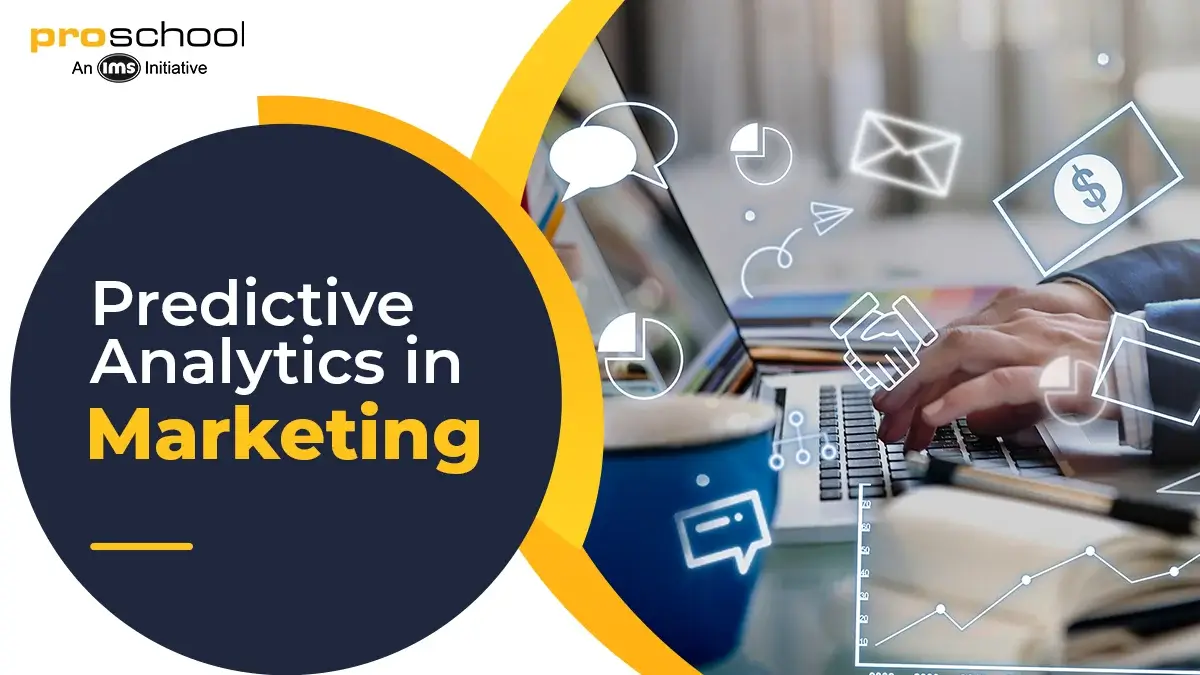7 Ways Predictive Analytics in Marketing Can Skyrocket Your ROI

Here's What We've Covered!
As business analytics continues to grow, it thrives on pillars like predictive analytics to continue flourishing. Predictive analytics is the use of statistical modelling and historical data to predict future outcomes and events. Its applications are as widespread as the presence of data, use cases commonly found in the field of healthcare, manufacturing, finance, retail, and marketing. In fact, the global market of predictive analytics is expected to grow by a CAGR of 24.4% in the next 7 years. The field continues to advance, and so do its applications.
In recent years, businesses have shifted their focus, resources, and effort towards marketing and exploring its full potential. Combine marketing with the practice of predictive analytics, you have a powerful duo that can transform the way businesses experience reach. As the market grows more competitive, data-driven decision making is crucial to give businesses a competitive edge and help them prepare for future scenarios. By leveraging data, marketers can improve ROI, enhance customer experience, and reduce risk.
Also Read- What Is Predictive Analytics? Usage, Algorithms & How To Learn
Applications of Predictive Analytics Transforming Marketing
Yes, predictive analytics is revolutionising the way marketing functions by enabling better experiences and smoother functions. A report suggested that 95% of companies use AI-powered predictive analytics to guide their marketing strategies. Since the applications of predictive analytics are quite widespread and adaptable, businesses are making the most of it. Here are some applications of predictive analytics in marketing:
1. Personalised Marketing
With the help of predictive analytics, highly personalised experiences have been enabled which resonate deeply with individual customers. By analysing large amounts of data, marketers anticipate the customer preferences and needs, which help them curate tailor-made messages and offers with unprecedented accuracy. Data from several touchpoints like purchase history, social media activity, and browsing history, is used to deliver highly personalised recommendations and marketing campaigns.
Case Study: Netflix’s Personalised Recommendations
Challenge: Deliver personalised experiences to over 282 million subscribers spanning across 190+ countries.
Solution: A prime example of predictive analytics, Netflix’s recommendation engine is highly personalised for the users. By analysing viewer history, types of content, user ratings, and other data, Netflix runs algorithms which gauge the user’s preferences. Once the user’s data is recorded and analysed, Netflix shares personalised content recommendations, leading to increased user satisfaction and less churn.
Result: Over 75% of the content users watch on Netflix comes from the personalised recommendations shared. Not only did this help boost revenue, but made a significant impact on the user’s experience!
2. Customer Segmentation
Amidst the sea of different types of customers, customer segmentation helps in dividing a customer base into smaller, manageable groups with shared behaviours and similar characteristics. With predictive analytics, segmentation goes beyond traditional demographics like age and location, and uncovers more nuanced customer insights. It understands customer needs and preferences, and segments them based on their purchase history, buying behaviour, etc.
Case Study: Amazon’s Predictive Customer Segmentation
Challenge: Amazon serves as a global marketplace with a vast and diverse use base. It required effective customer segmentation to deliver personalised experiences and maximise customer lifetime value.
Solution: Amazon utilised an advanced data platform to segment customers based on their purchase history, demographic data, product interests, and email engagement. With the analysed data in hand, Amazon sent personalised email recommendations with features like, “Customers who bought this also bought,” targeted promotions, and discounts to users based on their interests and purchase history.
Result: This personalised approach led to higher conversion rates, increased revenue, and better customer experiences.
3. Predictive Customer Churn
Predictive analytics helps identify customers at high-risk of leaving the company, and such an advanced prediction gives time to businesses to implement their retention strategies. It uses techniques like Customer Lifetime Value (CLV) to determine the long-term value of a customer, machine learning models to predict the probability of churn, and analyses customer behaviour by examining factors like customer service interactions, purchase history, etc.
Case Study: Netflix’s Churn Prediction
Challenge: Among the many streaming platform competitors like Disney, Amazon Prime, etc., Netflix faced the threat of increasing churn due to more competition.
Solution: Netflix leveraged sophisticated predictive analytics models to identify subscribers at high-risk of churning. They collected data based on viewing history, plan usage, and customer graphics to understand user behaviour. By utilising machine learning algorithms, they analysed user data to predict the probability of the churn based on factors like viewing activity, plan changes, etc. These predictions set the base for targeted retention strategies which were implemented to prevent the customer churn.
Result: Netflix’s churn rate decreased from 4% in 2022 to 2.5% in 2023 with the help of effective retention strategies that were implemented right on time.
4. Social Media Marketing
Social media platforms generate data in large amounts. Predictive analytics uses this data to understand user behaviour, predict trends, and optimise marketing campaigns maximum impact. Predictive content marketing can help forecast trends and content performance, based on historical data, which allows for content optimisation and creation. It also helps in targeted advertising by identifying and targeting specific audience segments based on their demographics, online behaviour, and interests.
Case Study: Starbucks’ Predictive Social Media Marketing
Challenge: With millions of customers and a wide range of products and services, Starbucks needed to understand customer behaviour and preferences to optimise their marketing campaigns.
Solution: Starbucks collected a large amount of data on user behaviour, based on social media interactions, purchase history, mobile app usage, etc. They developed predictive models to forecast demand for specific products, identify customers at risk of churn, and predict customer preferences for new products and promotions. With the data gathered and analysed, Starbucks sent targeted offers and promotions to customers based on their preferences and history, along with personalised recommendations and location-based offers.
Result: This personalised approach improved Starbucks’ user experience to a great extent, a lot of which led up to 13M+ active users of the rewards program!
5. Product Recommendations
Personalised marketing allows brands to share product recommendations which are specifically curated for the user. By leveraging predictive analytics, relevant products can be suggested to customers based on their previous browsing and purchasing history. It includes content-based filtering which recommends products based on the attributes of the items, and collaborative products based on the preferences of similar users. This system aims to increase customer engagement, drive sales, and enhance the overall customer experience for the users.
Case Study: Amazon’s Personalised Product Recommendations
Challenge: Amazon has hundreds of millions of customers to cater to, with a vast product catalog. The combination of a large user base with an equally big product catalog makes personalised recommendations a huge challenge, as well as a dire need for the brand.
Solution: Amazon employs a sophisticated recommendation engine to utilise a combination of techniques, including collaborative and content-based filtering. By analysing purchase history to see the products frequently bought together, and browsing search history, it enhanced its product recommendation system and made it more relevant to the products as well as the user’s preferences.
Result: Personalised product recommendations drive nearly 30% of the revenue Amazon makes, not to mention the wonderful user experience it delivers too!
6. Ad Optimisation
Many businesses rely on different types of advertising to market their products and services. Predictive analytics optimises ad campaigns across various channels, including social media, search ads, display ads, etc. It requires analysing large amounts of data with techniques like real-time bidding to adjust prices according to the competitors, audience targeting, content optimisation, understanding customer journeys and marketing channels. Such analyses enable marketers to make more data-driven decisions which improve ad performance and maximise ROI.
Case Study: Google Ads’ Predictive Bidding
Challenge: A platform for brands to run business ads. Google Ads wanted to maximise the return on ad spend (ROAS) for advertisers. Across a massive scale of auctions, Google wanted to optimise bids in real-time and outperform the competitors.
Solution: Google Ads leveraged advanced machine learning algorithms to predict the likelihood of various outcomes for every ad impression, like click-through rate (CTR), conversion rate, and cost-per-conversion. By analysing these predictions, the optimal bid for each ad impression in real-time auctions were determined and implemented. As the algorithms constantly learn and adapt based on real-time performance data, bids and strategies were adjusted in a quick and efficient manner.
Result: Google Ads take into account many factors like user interest, previous site visits, physical location, etc., and actually stays true to the term “smart bidding.” Not only does it optimise the many manual efforts that go into bidding, but also enhance the experience for the users as well as the businesses.
7. Forecasting Future Trends
Predictive analytics enables marketers to go beyond reacting to current trends and proactively predict future market shifts, competitive landscapes, and consumer behaviours. By analysing social media conversations, new articles, search engine queries, and other data sources, emerging trends in consumer behaviour, interests, and preferences can be identified. Based on these predictions, marketers can anticipate future changes in trends, consumer behaviour, etc., and strategise accordingly.
Case Study: Google Trends’ Predictive Consumer Behaviour
Challenge: Google, with all its vast user and search data, wanted to understand the changing consumer interests in order to predict future trends.
Solution: Google Trends analyses billions of Google Search queries to identify patterns and trends that come through. It utilises machine learning algorithms to forecast future search volume for specific topics and keywords, emerging trends and their impact, and to predict the adoption and diffusion of new technologies and consumer behaviours. Such data will help identify emerging product categories and consumer needs, as well as in making more informed decisions about marketing campaigns and business strategies to plan and implement.
Result: Google uses trend data to make the process of developing new products and services more informed. It also helps boost more effective marketing campaigns and take strategic business decisions.
Also Read – Top 5 Predictive Analytics Tools for Smarter Business Decisions in 2025
Top Predictive Analytics Tools for Marketing
There are many predictive analytics tools available for marketing. Each tool focuses on a different area of application, has a unique approach, and a variety of offerings. Here’s a quick breakdown of the top predictive analytics tools for marketing and their key features:
1. Google Analytics
Focus: User behaviour tracking, conversion tracking, website and app analytics.
Key features:
- Available in a free version
- Solid data collection capabilities
- Audience segmentation
- Cross-platform tracking
- Integration with Google Ads
Best for: Businesses, big and small alike, who are heavily reliant on digital channels for marketing.
2. Adobe Analytics
Focus: Cross-channel analysis, customer journey analysis, advanced web and mobile analytics.
Key features:
- Powerful data segmentation and analysis capabilities
- Customer churn prediction
- Strong focus on customer experience
- Integration with other Adobe Marketing Cloud platforms
Best for: Enterprises with complex marketing needs and a desire for deeper, better customer insights.
3. IBM SPSS Modeler
Focus: Data mining, machine learning, and advanced statistical analysis.
Key features:
- Data preparation tools
- Visualisation capabilities
- Comprehensive set of statistical and machine learning algorithms
Best for: Businesses with strong analytical objectives and a team with advanced statistical skills.
Learn how to develop analytical skills with IMS Proschool’s Business Analytics Program!
4. SAS
Focus: Comprehensive business analytics platform, sophisticated machine learning and statistical capabilities.
Key features:
- Data mining and predictive analytics
- Powerful statistical modelling
- Strong in risk management, customer intelligence, and fraud detection
Best for: Organisations with large data volumes and strong analytical needs.
5. Python and R
Focus: Statistical modelling, machine learning, and extensive libraries for data analysis.
Key features:
- Highly flexible and customisable
- Access to cutting-edge research and development
- Large and active communities
Best for: Business analysts and data scientists with strong analytical and problem-solving skills.
6. Marketing Cloud Platforms
Example: Salesforce Marketing Cloud, Hubspot, etc.
Focus: integrated marketing platforms with built-in analytics and strong predictive capabilities.
Key features:
- Social media marketing analysis
- Email marketing analysis
- Marketing automation
- Customer relationship management
Best for: Organisations looking for a one-stop marketing platform with integrated analytics capabilities.
Also Read- Business Analytics vs Data Science: Know The Exact Difference
Steps to Implement Predictive Analytics in Marketing
- Define business objectives and key performance indicators (KPIs). Clearly define what you are trying to achieve, and set measurable goals with KPIs like website traffic, conversion rates, return on investment, etc., to measure the marketing efforts and their impact.
- Collect and prepare relevant data for analysis from multiple sources. Customer data like purchase and browsing history, data from marketing campaigns, and market data can all make up for relevant data touchpoints. Clean the data by handling missing values and correcting inconsistencies to make sure the data is accurate.
- Derive new features from existing data to improve the model’s accuracy. Select the most relevant features to reduce overfitting and improve the model’s overall performance.
- Select machine learning algorithms best suitable for the specific marketing problem. Assess their performance by training and validating models using appropriate techniques. Finally, optimise model parameters to improve predictive power and accuracy.
- Deploy the models by integrating them with CRM systems, marketing automation platforms, and other relevant tools. The performance of the models must be monitored continuously to identify any issues early on. Update the models with new data and retrain them regularly to maintain effectiveness and accuracy.
- By monitoring the impact of predictive analytics on marketing performance, analyse the results and draw insights to refine strategies and make them more future-proof.
Also Read- 5 Mind-blowing ways predictive analytics is transforming human resources
Emerging Trends in Predictive Marketing Analytics
There are many new trends embracing predictive marketing analytics in the coming years. These trends mark the upward movement of the use of predictive analytics in marketing. The implementation of predictive analytics benefits businesses with wonderful insights that help them predict future outcomes. Embracing more new trends in predictive analytics will make the domain much more efficient and advanced. Here are some emerging predictive analytics trends in marketing:
1. Predictive Customer Journey Analytics
Moving ahead from simple touchpoint analysis, predictive customer journey analytics will help understand the user’s entire journey across channels. It will also be equipped to understand and forecast customer behaviour at each stage in order to identify any roadblocks.
2. AI-powered Personalisation
With artificial intelligence, audience segmentation will go beyond the basics to deliver highly personalised experiences. By leveraging AI algorithms like deep learning, businesses will be able to provide truly personalised content suggestions, product recommendations, and even customised pricing!
3. Augmented Reality and Virtual Reality
Using predictive analytics, businesses will be able to personalise augmented reality (AR) and virtual reality (VR) experiences for individual customers. This will enhance the experience for users in a way that is more resonatory, relatable, and delightful.
4. Customer Data Platform
The rise of customer data platforms (CDPs) will provide a unified view of customer data across all channels which will enable more insightful and accurate predictive analytics. CDPs will also help to improve data quality to ensure data consistency across the organisation.
5. Data Privacy and Ethical Considerations
There is an increasing focus on AI models to remain transparent and explainable to build trust with customers. Marketers can ensure the ethical use of customer data by adhering to data privacy regulations. It will also help in identifying and mitigating any biases in data and algorithms to ensure fairness and more accuracy in the outcomes.
Also Read- 4 Predictive Analytics Models Transforming Forecasting in 2025
Excel in Business Analytics with IMS Proschool
If the field of marketing and data analytics are equally exciting for you, the best of both worlds meet at business analytics! Business analysts are high in demand for their strong problem-solving and analytical skills. Their expertise in both business understanding and analytical powers are just the combination businesses need to implement business analytics.
And where there’s analytics, there’s IMS Proschool. Ranked among India’s top 10 analytics institutes, IMS Proschool’s Business Analytics Program is a comprehensive guide to learning business analytics and mastering the craft. Here are some highlights of the business analytics program:
- Learn from 15+ case studies and projects to know how to apply your theoretical knowledge in the real world.
- Easily upgrade your course to domain specific analytics like marketing, human resources, finance, etc.
- Develop and enhance a problem-solving mindset and strong analytical capabilities.
- Learn business analytics tools that are high in demand, including Excel, SQL, Power BI, Python, and Tableau.
- Explore 30+ companies and 800+ roles and begin your career as a business analyst!
Conclusion
Predictive analytics enables businesses to take proactive measures and prepare well in advance for the potential events and outcomes. Advanced planning gives businesses a competitive advantage, and data insights make important decisions more informed and less uncertain. All these little efforts amount up to an increase in ROI, improved experiences, and growth and success for the businesses!
Frequently Asked Questions
1. What is predictive analytics in marketing?
Predictive analytics in marketing utilises data and statistical as well as machine learning algorithms to forecast future market trends and customer behaviour. It goes beyond simply analysing past data and also anticipates future outcomes such as customer churn, campaign effectiveness, customer lifetime value, customer preferences, etc.
2. How does predictive analytics benefit marketing?
Predictive analytics benefits the field of marketing by increasing revenue, improving ROI, enhancing customer experience, reducing risks, and enabling more data-driven decisions which gives them a competitive edge.
3. What is the goal of predictive analytics in marketing?
The primary goal of predictive analytics in marketing is to achieve business objectives and optimise marketing performance. It achieves this goal by increasing customer acquisition, improving customer retention, building strong customer relationships, and driving sales and revenue growth.
4. What are the four types of business analytics?
There are four types of business analytics, as follows:
- Descriptive analytics to understand past performance
- Diagnostic analytics to investigate the “why” behind what happened.
- Predictive analytics to forecast future outcomes and events
- Prescriptive analytics to recommend actions to take based on predictions.
Resent Post
>
Which Courses After 12th Commerce With High Salary Are in Demand Worldwide?
>
How to Find ACCA Jobs Online After Qualifying: Real Portals, Tips & Career Guidance
>
Financial Modelling Classes in Hyderabad: Your Guide to the Best Institutes
>
Still Paying CFA Enrollment Fees? Here’s the Big 2026 Update!
>
How to Use myACCA Like a Pro: Dashboard, Exams, Deadlines & More!
Follow Us For All Updates!



